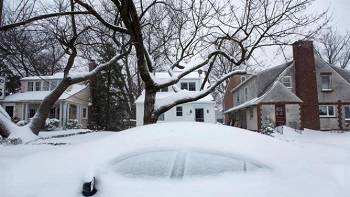As winter storm Jonas entered its second day, it seemed there was no slowing down for one of the biggest blizzards in US history.
Up to 85 million people lie in the storm's path, which spans the East Coast and Mid-Atlantic, affecting residents from New York to North Carolina.
The massive storm has brought several eastern cities to a standstill, effectively shutting down New York and Washington DC.
Official reports suggest that at least 18 people have been killed nationwide in weather-related incidents, while in the past 48 hours, 11 states have issued states of emergency.
By Saturday afternoon, New York had started enforcing a full travel ban.
"After 2:30pm [EST] and you're on the road, we will arrest you," James P. O'Neill, the NYPD Chief of Department, said at a press conference.
However, despite strict warnings, government officials said they were concerned by the number of residents who continued to leave their homes.
"Stay home, shelter in a warm place and allow snow plough operators and emergency responders to have free passage and control of the road ways," Leif Dormsjo, the Director of Washington DC's Department of Transportation, told Al Jazeera.
"Being outside in this weather is dangerous and life-threatening. You are putting yourself at risk, and operators of specialized equipment at risk. We really need to keep the roads clear of any private vehicles."
By late early evening local time, snow levels had reached up to 40 inches in Virginia, 38 inches in Maryland, 35 inches in Pennsylvania, with New Jersey, New York and Washington DC following closely behind.
Airlines were also feeling the impact of the storm, with over 10,100 flights cancelled between Friday and Sunday, according to airline tracker Flight Aware.
Speaking to Al Jazeera, Mary Flannery, a Philadelphia International Airport spokeswoman, said: "All of our airlines cancelled flights for today [Saturday]. We have our own employees and contractors working around the clock to clear the snow, to clear the runways, the taxi ways, the sidewalks and parking walks."
Although the airport hoped to resume flights as early as Sunday, Flannery insisted this "will be among one of the deepest snow storms we’ve ever seen."
The storm has also left thousands of residents without power. In North Carolina alone, 110,357 homes were without electricity by mid-afternoon Saturday. In New Jersey, where Governor Chris Christie declared a state of emergency on Friday evening, at least 40,000 households were without power.
'Absolute extremes'
Homeless shelters across the East Coast region struggled to cope on Saturday as they sought to provide refuge for those most vulnerable.
"It's times like these that we are being pushed to absolute extremes," said Deborah Chambers of Central Union Mission in DC - an NGO that runs an emergency shelter programme.
"We are locked down by this storm and are reaching the limitation of our resources. We need blankets, food, shoes and coats to protect the most vulnerable…hopefully no one will lose their lives," Chambers told Al Jazeera.
Emergency response teams feared residents being indirectly exposed to danger by the storm.
"The thing we worry about is those who have medical emergencies, home fires and carbon monoxide poisoning," Russ Paulsen, executive director of Community Preparedness and Resilience for the American Red Cross, told Al Jazeera.
"More people die from traffic accidents in storms, than from direct effects of the storm itself."
As police and ambulance sirens were heard throughout Washington DC, residents of the city, and across the coastal region, feared another night of bitter and menacing cold.
"This storm is not done yet," Washington DC's Mayor, Muriel Bowser, told reporters on Saturday evening, "and it’s still very dangerous."
PHOTO CAPTION
Snow accumulates on vehicles parked along Jenifer Street during a major blizzard in Washington, DC, USA, 23 January 2016.
Al-Jazeera


 Home
Home Discover Islam
Discover Islam Quran Recitations
Quran Recitations Lectures
Lectures
 Fatwa
Fatwa Articles
Articles Fiqh
Fiqh E-Books
E-Books Boys & Girls
Boys & Girls  Articles
Articles










